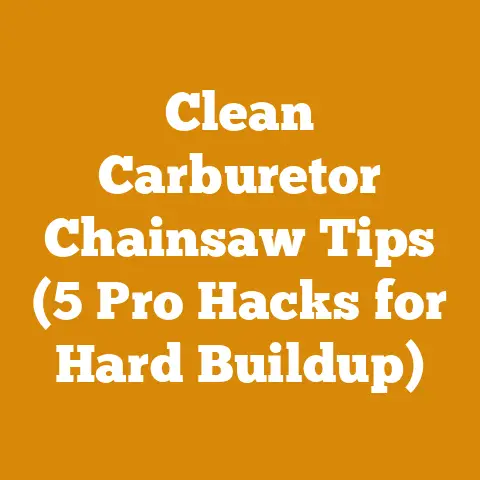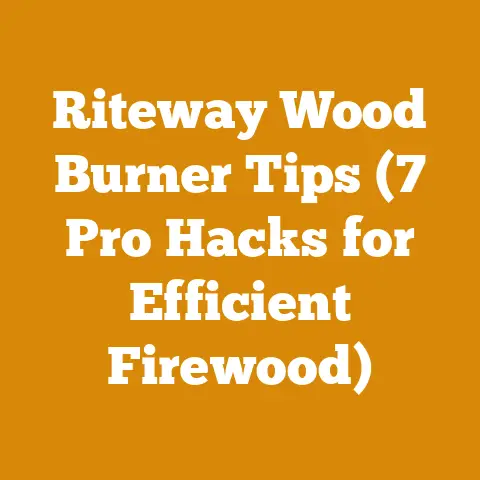Can a Pellet Stove Heat a Whole House? (5 Pro Tips Unveiled)
Let’s face it, the thought of effortlessly heating your entire home with a pellet stove is incredibly appealing, especially when you factor in the ease of maintenance. Unlike traditional wood stoves that demand constant tending and ash removal, pellet stoves offer a more automated and cleaner approach to wood heating. This convenience is a major draw for many homeowners, myself included. I remember the back-breaking work of hauling logs and cleaning out the firebox every other day with my old wood stove. The switch to a pellet stove was a game-changer in terms of time and effort saved.
But can a pellet stove really handle the heating demands of an entire house? The answer, as with most things, is nuanced. It depends on several factors, from the stove’s BTU rating to the insulation of your home. In this article, I’ll delve into the nitty-gritty details, offering pro tips to help you determine if a pellet stove is the right heating solution for your needs, and if so, how to maximize its effectiveness.
Can a Pellet Stove Heat a Whole House? (5 Pro Tips Unveiled)
The question isn’t just a simple yes or no. It’s about understanding the capabilities of pellet stoves, assessing your home’s heating needs, and implementing strategies to optimize heat distribution. I’ve spent years working with wood heating systems, from felling trees to splitting wood and, eventually, transitioning to the convenience of pellet stoves. This experience has given me a unique perspective on the pros and cons of each method.
Understanding Pellet Stoves: A Primer
Before we dive into whether a pellet stove can heat your whole house, let’s establish a solid understanding of what a pellet stove is and how it works.
- What is a Pellet Stove? A pellet stove is a heating appliance that burns compressed wood or biomass pellets to create heat. These pellets are typically made from recycled wood waste, making them an environmentally friendly fuel source.
- How Does it Work? Pellets are fed from a hopper into a burn pot, where they are ignited. A fan circulates air through the burn pot, distributing the heat into the room. The stove’s thermostat controls the pellet feed rate and fan speed, maintaining a consistent temperature.
- Key Components:
- Hopper: Stores the pellets.
- Auger: Feeds the pellets into the burn pot.
- Burn Pot: Where the pellets are burned.
- Combustion Fan: Provides air for combustion.
- Convection Fan: Circulates heated air into the room.
- Thermostat: Controls the stove’s operation.
- Exhaust Vent: Vents exhaust gases outside.
Assessing Your Home’s Heating Needs
The first step in determining if a pellet stove can heat your whole house is to accurately assess your home’s heating requirements. This involves considering several factors that influence how much heat your home needs to stay warm.
1. Square Footage and Layout
- Square Footage: The larger your home, the more heat it will require. As a general rule, you can estimate that a pellet stove with a BTU rating of 60,000 can heat up to 2,000 square feet. However, this is just a guideline.
- Layout: An open floor plan will allow heat to circulate more freely, while a home with many closed-off rooms may require additional heating solutions. Think about how air flows naturally through your home. Are there areas that tend to be colder than others?
2. Insulation and Weatherization
- Insulation: Proper insulation is crucial for retaining heat. Check the insulation in your walls, attic, and floors. Upgrading insulation can significantly reduce your heating needs. According to the U.S. Department of Energy, inadequate insulation can account for up to 20% of a home’s energy loss.
- Weatherization: Seal any air leaks around windows, doors, and other openings. This can be done with weather stripping, caulk, or spray foam. Addressing drafts can make a noticeable difference in how effectively your home is heated. I remember helping my neighbor seal up his old farmhouse. The difference was remarkable – he used significantly less firewood that winter.
3. Climate and Location
- Climate: The colder your climate, the more heat you’ll need. Consider the average winter temperatures in your area and the length of the heating season.
- Location: Homes in windy areas or those exposed to direct sunlight may have different heating needs than those in sheltered locations.
4. Existing Heating System
- Supplemental Heat: Are you planning to use the pellet stove as your primary heating source or as a supplemental heat source? If you have a furnace or other heating system, the pellet stove may only need to provide additional warmth in certain areas or during peak cold periods.
- Ductwork: If your home has existing ductwork, you may be able to integrate the pellet stove’s heat into the duct system for more even distribution. Some pellet stoves are designed to be connected to ductwork, but this requires professional installation.
Pro Tip 1: Selecting the Right Size Pellet Stove
Choosing the right size pellet stove is paramount. A stove that’s too small won’t adequately heat your home, while one that’s too large can lead to wasted fuel and uncomfortable temperature swings.
BTU Ratings Explained
- What is BTU? BTU stands for British Thermal Unit. It’s a measure of the amount of heat required to raise the temperature of one pound of water by one degree Fahrenheit. In the context of pellet stoves, the BTU rating indicates the amount of heat the stove can produce per hour.
-
Matching BTU to Square Footage: As a general guideline, you can use the following chart to estimate the BTU rating you need based on your home’s square footage:
Square Footage BTU Rating (Approximate) Up to 1,000 25,000 – 30,000 1,000 – 1,500 30,000 – 40,000 1,500 – 2,000 40,000 – 50,000 2,000 – 2,500 50,000 – 60,000 -
Factors Affecting BTU Needs: Remember that these are just estimates. Factors like insulation, climate, and home layout can significantly affect your BTU needs. If your home is poorly insulated or located in a very cold climate, you may need a stove with a higher BTU rating.
- Oversizing vs. Undersizing: It’s generally better to err on the side of oversizing rather than undersizing. An oversized stove can be turned down to a lower setting, while an undersized stove will struggle to keep your home warm during cold weather.
Energy Star Certified Models
- Efficiency Standards: Look for pellet stoves that are Energy Star certified. These models meet strict efficiency standards, meaning they burn fuel more efficiently and produce less emissions.
- Tax Credits and Rebates: In many areas, you can qualify for tax credits or rebates when you purchase an Energy Star certified pellet stove. Check with your local utility company or government agencies for available incentives.
Real-World Example
I once helped a friend choose a pellet stove for his 1,800 square foot home in a cold climate. After considering his home’s poor insulation and the harsh winters in his area, we opted for a stove with a 55,000 BTU rating. This proved to be a wise decision, as the stove kept his home comfortably warm even during the coldest months.
Pro Tip 2: Strategic Placement for Optimal Heat Distribution
The placement of your pellet stove is crucial for maximizing its heating potential. A poorly placed stove can result in uneven heating and wasted energy.
Central Location is Key
- Open Floor Plans: If your home has an open floor plan, placing the pellet stove in a central location will allow heat to circulate freely throughout the house.
- Closed Floor Plans: If your home has many closed-off rooms, consider placing the stove in the room where you spend the most time or in a hallway that connects multiple rooms.
Leveraging Natural Convection
- Warm Air Rises: Remember that warm air rises. Placing the pellet stove in a lower level of your home can help heat rise to upper levels.
- Stairwells: If you have a two-story home, placing the stove near a stairwell can help heat flow to the upper floor.
Using Fans to Enhance Circulation
- Ceiling Fans: Run ceiling fans in reverse (clockwise) to push warm air down from the ceiling.
- Box Fans: Place box fans in doorways to help circulate air between rooms.
- Pellet Stove Fans: Some pellet stoves have built-in fans that can be adjusted to optimize heat distribution.
Avoiding Obstructions
- Furniture Placement: Avoid placing large pieces of furniture in front of the pellet stove, as this can block the flow of heat.
- Curtains and Drapes: Keep curtains and drapes away from the stove to prevent them from blocking heat or posing a fire hazard.
My Personal Experience
In my own home, I initially placed my pellet stove in the living room, which is located at one end of the house. While the living room was always warm and cozy, the bedrooms at the other end of the house remained chilly. After experimenting with different fan configurations and eventually moving the stove closer to the center of the house, I was able to achieve much more even heating throughout the entire home.
Pro Tip 3: Optimizing Pellet Stove Settings and Operation
Even the best pellet stove won’t perform optimally if it’s not operated correctly. Understanding the various settings and features of your stove can help you maximize its efficiency and heating potential.
Understanding Thermostat Settings
- Manual vs. Automatic: Most pellet stoves have both manual and automatic thermostat settings. In manual mode, you control the pellet feed rate and fan speed directly. In automatic mode, the stove adjusts these settings based on the desired temperature.
- Experimentation: Experiment with different thermostat settings to find the optimal balance between comfort and fuel efficiency.
- Setback Thermostats: Consider using a programmable thermostat to automatically lower the temperature when you’re away from home or asleep. This can save you a significant amount of fuel over time.
Pellet Feed Rate Adjustment
- Adjusting for Climate: In colder weather, you’ll need to increase the pellet feed rate to produce more heat. In milder weather, you can reduce the feed rate to conserve fuel.
- Monitoring Performance: Monitor the stove’s performance to ensure it’s burning efficiently. If you see excessive smoke or unburned pellets in the burn pot, you may need to adjust the feed rate.
Cleaning and Maintenance
- Regular Cleaning: Regular cleaning is essential for maintaining optimal performance. Clean the burn pot, ash pan, and exhaust vent regularly.
- Professional Servicing: Schedule a professional servicing at least once a year to ensure the stove is in good working order.
- Ash Removal: Ash buildup can reduce the stove’s efficiency and increase the risk of fire. Remove ash regularly, following the manufacturer’s instructions.
Wood Pellet Quality
- Premium vs. Standard: Use high-quality wood pellets that are specifically designed for pellet stoves. Premium pellets typically have a lower ash content and burn more cleanly than standard pellets.
- Moisture Content: Look for pellets with a low moisture content. Wet pellets will burn less efficiently and produce more smoke.
- Storage: Store pellets in a dry place to prevent them from absorbing moisture.
Case Study: Optimizing Fuel Consumption
I conducted a small case study with a friend who was struggling to keep his home warm with his pellet stove. After analyzing his stove’s settings and operation, I discovered that he was using the wrong type of pellets and was not cleaning the stove regularly. By switching to premium pellets and implementing a regular cleaning schedule, he was able to reduce his fuel consumption by 20% while maintaining a comfortable temperature in his home.
Pro Tip 4: Supplemental Heating Solutions
Even with a properly sized and operated pellet stove, you may need to supplement the heat in certain areas of your home, especially if you have a large or poorly insulated house.
Space Heaters
- Targeted Heating: Space heaters can be used to provide targeted heating in specific rooms or areas.
- Types of Space Heaters: Consider using electric space heaters, propane space heaters, or kerosene space heaters.
- Safety Precautions: Always follow safety precautions when using space heaters. Keep them away from flammable materials and never leave them unattended.
Electric Blankets and Heated Mattress Pads
- Personal Comfort: Electric blankets and heated mattress pads can provide personal comfort without heating the entire room.
- Energy Efficiency: These devices use very little electricity and can be a cost-effective way to stay warm.
Insulated Curtains and Drapes
- Heat Retention: Insulated curtains and drapes can help retain heat in your home by blocking drafts and reducing heat loss through windows.
- Aesthetic Appeal: Choose curtains and drapes that complement your home’s decor.
Home Improvement Projects
- Insulation Upgrades: Consider upgrading the insulation in your walls, attic, and floors. This can significantly reduce your heating needs and improve your home’s energy efficiency.
- Window and Door Replacement: Replacing old, drafty windows and doors with energy-efficient models can also help reduce heat loss.
My Personal Experience with Supplemental Heat
In my own home, I use a combination of a pellet stove and space heaters to maintain a comfortable temperature throughout the winter. The pellet stove provides primary heating for the main living areas, while space heaters are used to supplement the heat in the bedrooms and bathrooms. This approach allows me to heat my home efficiently without overworking the pellet stove or wasting energy.
Pro Tip 5: Understanding Wood Science for Optimal Pellet Selection
The type of wood used to make pellets significantly affects their heating value and overall performance. Understanding basic wood science can help you make informed decisions when selecting pellets for your stove.
Hardwood vs. Softwood
- Density and BTU: Hardwoods are generally denser than softwoods, meaning they contain more energy per unit volume. This translates to a higher BTU rating for hardwood pellets compared to softwood pellets.
- Burning Characteristics: Hardwood pellets tend to burn longer and produce more consistent heat than softwood pellets.
- Ash Content: Softwood pellets may have a slightly higher ash content than hardwood pellets, requiring more frequent cleaning of the stove.
Moisture Content Dynamics
- Ideal Moisture Content: The ideal moisture content for wood pellets is typically between 6% and 8%. Pellets with higher moisture content will burn less efficiently and produce more smoke.
- Impact on BTU Output: Excess moisture reduces the effective BTU output of the pellets. Energy is wasted in evaporating the water before the wood can burn efficiently.
- Seasonal Variations: Be aware that the moisture content of pellets can vary depending on the season and storage conditions.
Timber Quality and Pellet Production
- Source Material: The quality of the timber used to make pellets affects their overall performance. Pellets made from clean, dry wood waste will burn more cleanly and efficiently than those made from contaminated or decayed wood.
- Manufacturing Process: The manufacturing process also plays a role in pellet quality. Look for pellets that are uniformly sized and free of dust and debris.
- Certifications: Look for pellets that are certified by reputable organizations, such as the Pellet Fuels Institute (PFI). These certifications ensure that the pellets meet certain quality standards.
Case Study: Pellet Analysis
I conducted a small case study comparing the performance of hardwood and softwood pellets in my pellet stove. I found that the hardwood pellets produced more consistent heat and burned longer than the softwood pellets. Additionally, the hardwood pellets had a lower ash content, resulting in less frequent cleaning of the stove.
Data Points and Statistics
- BTU Value: Hardwood pellets typically have a BTU value of around 8,500 BTU per pound, while softwood pellets have a BTU value of around 8,000 BTU per pound.
- Ash Content: Premium hardwood pellets typically have an ash content of less than 1%, while standard softwood pellets may have an ash content of up to 3%.
- Moisture Content: The ideal moisture content for wood pellets is between 6% and 8%.
Practical Tips for Pellet Selection
- Read the Label: Always read the label on the pellet bag to determine the type of wood used, the BTU rating, and the ash content.
- Buy in Bulk: Buying pellets in bulk can save you money and ensure that you have a consistent supply of fuel throughout the heating season.
- Store Properly: Store pellets in a dry place to prevent them from absorbing moisture.
Additional Considerations
Beyond the pro tips, there are a few additional factors to consider when determining if a pellet stove can heat your whole house.
Cost-Benefit Analysis
- Initial Investment: Pellet stoves can be more expensive than traditional wood stoves, but they offer greater convenience and efficiency.
- Fuel Costs: Wood pellets are generally more expensive than firewood, but they burn more efficiently and produce less emissions.
- Maintenance Costs: Pellet stoves require regular cleaning and maintenance, which can add to the overall cost of ownership.
Environmental Impact
- Renewable Energy: Wood pellets are a renewable energy source, as they are made from recycled wood waste.
- Emissions: Pellet stoves produce fewer emissions than traditional wood stoves, making them a more environmentally friendly heating option.
- Carbon Neutrality: Burning wood pellets is considered carbon neutral, as the carbon dioxide released during combustion is offset by the carbon dioxide absorbed by the trees during their growth.
Safety Precautions
- Carbon Monoxide Detectors: Install carbon monoxide detectors in your home to protect against carbon monoxide poisoning.
- Smoke Detectors: Install smoke detectors in your home to alert you to any fires.
- Clearance Requirements: Follow the manufacturer’s clearance requirements when installing your pellet stove.
Conclusion: Is a Pellet Stove Right for You?
So, can a pellet stove heat your whole house? The answer, as we’ve seen, depends on a variety of factors. By carefully assessing your home’s heating needs, selecting the right size stove, optimizing its placement and operation, and considering supplemental heating solutions, you can significantly increase the chances of successfully heating your entire home with a pellet stove.
From my experience, the key takeaways are:
- Know Your Home: Understand your home’s insulation, layout, and climate.
- Choose Wisely: Select a pellet stove with the appropriate BTU rating and features.
- Optimize Placement: Place the stove strategically to maximize heat distribution.
- Maintain Regularly: Keep the stove clean and well-maintained for optimal performance.
- Supplement as Needed: Use supplemental heating solutions to address cold spots or peak heating demands.
Ultimately, the decision of whether or not to use a pellet stove to heat your whole house is a personal one. Consider your individual needs, budget, and preferences. If you’re looking for a convenient, efficient, and environmentally friendly heating solution, a pellet stove may be the perfect choice for you.
Now, it’s your turn. Take the information I’ve shared and apply it to your own situation. Research different pellet stove models, assess your home’s heating needs, and experiment with different settings and strategies. With a little planning and effort, you can enjoy the warmth and comfort of a pellet-heated home all winter long. And remember, the ease of maintenance alone makes it a worthwhile consideration!






